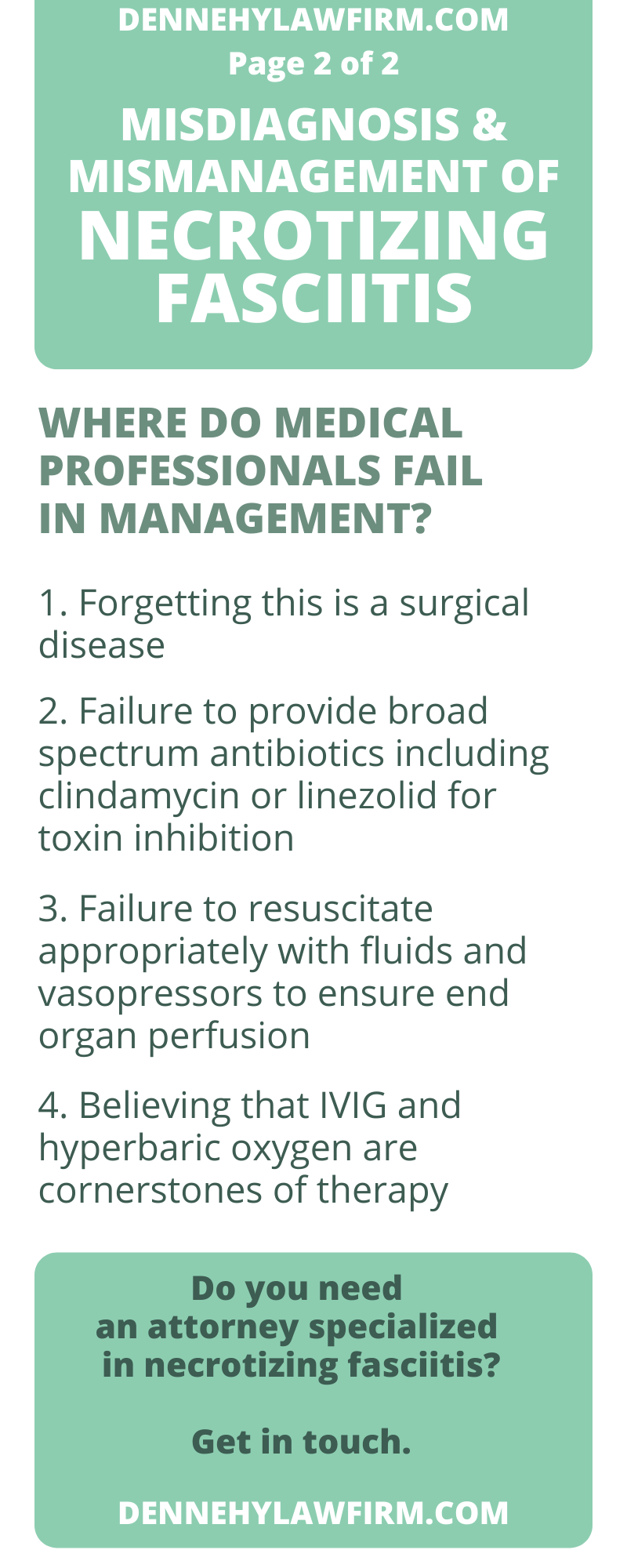If you reading this post, you, or a loved one, may have already suffered consequences due to medical malpractice or negligence. In that case, you may also have a case for a necrotizing fasciitis lawsuit.
To determine whether you might have a case, please get in touch with our team for a free consultation. Dennehy Law Firm has successfully handled necrotizing fasciitis lawsuits and other infections.
Note: In New York State, the statute of limitations for medical malpractice is two years and six months. Filing your medical malpractice lawsuit, whether for necrotizing fasciitis or otherwise, as soon as you can is essential and may increase your chances of winning your case.

*Please make sure to read our disclaimers relating to this article – see below.
Table of Contents
Examples of Necrotizing Fasciitis lawsuit
In the United States, the Centers for Disease Control and Prevention (CDC) monitor national cases of necrotizing fasciitis caused by Group A Streptococcus (this is one type of bacteria that causes Necrotizing fasciitis – see below for a full list).
According to their records, since 2010, around 700 – 1200 cases occur per year – the figure is likely much higher. However, case numbers in general do not appear to be rising.
Example 1: The following necrotizing fasciitis lawsuit was settled for $900,000.
A young man was experiencing increasing pain in his lower leg and other symptoms associated with infection. He went to the ER several times over the course of a few days. On his final visit, he was left unattended for a few hours. By the time he was next attended, he had redness in the area of his lower leg, increased pain and trouble breathing. Unfortunately, it was too late for surgery.
Example 2: The following necrotizing fasciitis lawsuit was settled for $1,300,000.
In another lawsuit, an adult male (a father and husband) approached the hospital with clear, and worsening, indications of infection. As is typical in these cases, diagnosis of the infection was delayed as was any treatment. By the time medical staff diagnosed the infections, neither amputation nor antibiotic treatment could save this man’s life.
Do I have a necrotizing fasciitis Case?
To determine whether you have a necrotizing fasciitis case, we strongly recommend that you get in touch for a free consultation. In doing so, our team will have a better picture of your case, current situation and damages.
The attorney that takes on your necrotizing fasciitis lawsuit will need to prove the four elements of malpractice:
- Duty – Was there a patient-doctor relationship? Did your doctor, nurse, surgeon etc provide competent care?
- Dereliction / breach of duty – Did your surgeon leave a tool inside your body? Was there misdiagnosis? Did they fail to recognize symptoms of an infection?
- Direct cause / causation – You attorney needs to prove that negligence is what caused your injuries. This is more complicated than it might seem depending on your age, health, risk factors, medications and whether multiple health professionals were involved.
- Damages (this includes potential damages) – You must be able to prove your damages due to your illness and/or injuries. For example, were you unable to work as a result of your injuries? Did you have to pay for corrective surgery (or other medical bills)? Did you experience permanent physical impairment and a lower quality of life?
Once these four elements of malpractice have been proven, the jury in your trial will determine how much money represents proper compensation.
Investigation, review of medical records, interviews, and negotiation typically take place before a claim is even filed. In order to make sure you maximize the compensation you deserve due to your doctor’s negligence, it is important to contact an attorney right away to preserve your rights.
Necrotizing fasciitis lawsuit – types of damages
The amount of damages due as a result of necrotizing fasciitis depends on the level of injury you or a loved one has suffered. These can include economic losses, intangible damages and potential damages.
Economic losses may include (this is not an exhaustive list):
- nursing care
- physiotherapy and other types of therapy
- rehabilitation
- lost wages
- costs of domestic help required after injury
- additional medical bills, treatments, prescriptions
Intangible or non-economic losses may include (this is not an exhaustive list):
- pain & suffering
- scarring / disfigurement,
- depression / mental anguish
Potential damages may include (this is not an exhaustive list):
- Future inability to earn income
- Funeral costs
- Future medical expenses due to a chronic condition
What is Necrotizing Fasciitis?
Necrotizing Fasciitis, otherwise known as flesh-eating bacteria, is deadly but, fortunately, it is also extremely rare. When this type of infection is not diagnosed and treated on time, it can be fatal.
This type of deep tissue infection can overwhelm of immune system, leading to sepsis and/or sepsis shock.
Sepsis is a complication due to an infection. When sepsis occurs, our body releases chemicals into the bloodstream to counter an infection (like necrotizing fasciitis). However, this sudden injection of chemicals can cause inflammation which then might lead to other dangerous conditions and symptoms, such as multiple organ failure, fever, difficulty breathing, mental confusion, low blood pressure and even death.
Types of Necrotizing fasciitis Bacteria
A common myth about flesh-eating bacteria is that there is only ONE type. There are actually many types of bacteria that can lead to the condition known as necrotizing fasciitis, and the most common one is Group A Streptococcus, the same bacteria that causes strep throat.
Other types of bacteria that lead to necrotizing fasciitis are:
- Escherichia coli (“E Coli”)
- Clostridium
- Aeromonas hydrophila
- Pseudomonas
- Prevotella
- Klebsiella
- Vibrio vulnificus
- Staphylococcus aureus
Necrosis fasciitis is not the same as necrotizing fasciitis!
People often mistakenly use the term necrosis fasciitis when referring to necrotizing fasciitis. This is incorrect terminology. Necrosis describes the death of cells and tissue, which occurs during necrotizing fasciitis.
How do you get flesh-eating bacteria / Necrotizing fasciitis?
To get Necrotizing fasciitis, the following steps typically occur:
- Bacteria (one of the types listed above) gets lodged in our deep tissue though our blood or a wound.
- The bacteria kills a some of our tissue, creating the ideal breeding ground for bacteria.
- As the bacteria grows/reproduces, it starts to affect other parts of our body, killing tissue, overwhelming our system with toxins.
- Our immune system is unable to penetrate the bacteria since it is located inside dead tissue, which does not receive blood flow. Antibiotics are also ineffective for the same reason.
What are the symptoms of flesh-eating bacteria / necrotizing fasciitis?
Initially, symptoms for necrotizing fasciitis are easily overlooked since they resemble the flu and may or may not be associated to an external injury or wound.
However, within a few days, symptoms become increasingly more severe and, if not diagnosed in time, can quickly lead to death or the permanent loss of limbs or organs.
Early symptoms (within 24 hours) of an infection due to flesh-eating bacteria or necrotizing fasciitis include a combination of the following:
- may involve an open wound that may or may not appear infected
- general pain near wound – generalized is important (an entire limb, for instance)
- light swelling possible
- the pain experienced seems disproportionate to the wound/injury and begins to resemble a pulled muscle i.e. a deeper pain, not merely superficial
- flu-like symptoms including fever, fatigue, dizziness, nausea
More advanced symptoms (within 3-4 days) of this infections include:
- increased swelling in limb or region of body
- purplish rash appears
- appearance of dark marks in the region or limb, often quite large, that develop into blisters with dark brown/black fluid
- the wound/injury begins to look dead/necrotic including blue/white/dark and flaky
- increased and/or extreme pain
- elevated heart rate
- continued flu-like symptoms: fever, fatigue and dizziness
- trouble breathing, fast breathing
- purging/vomiting
As the infection becomes more severe, critical symptoms (within 4-5 days) may develop, which include:
- sepsis or septic shock – drastic drop in blood pressure, body inundated with toxins from accumulating bacteria
- clear indication of necrotic scarring – black necrotic patches
- weakness and dizziness may cause patient to faint and become unconscious
How can a Necrotizing fasciitis lawyer help?
An attorney specializing in necrotizing fasciitis cases will evaluate your case, conduct a thorough investigation of your case, review your medical records, receipts and expenses, conduct in-depth interviews with individuals involved in your case, and negotiate for damages.
Often times, negotiation takes place before a claim in filed. The sooner you contact a medical malpractice attorney, the more likely you will collect for damages and preserve your rights.
Do you believe you have a case for a necrotizing fasciitis lawsuit? Please get in touch today by email or phone.
*This article, and all others on our website, does not replace legal advice and cannot be used as such. Neither are these articles exhaustive. Please always inquire with certified legal counsel if you are pursuing a medical malpractice lawsuit of any sort.



